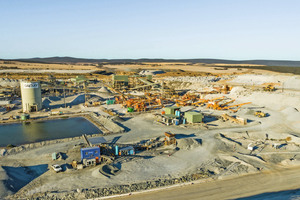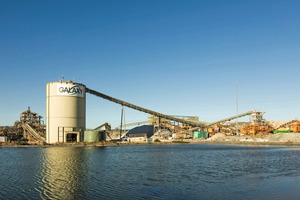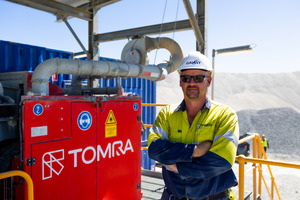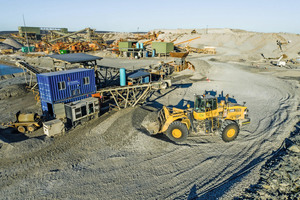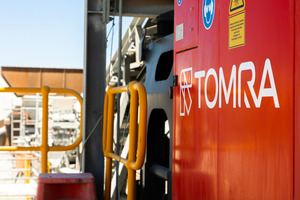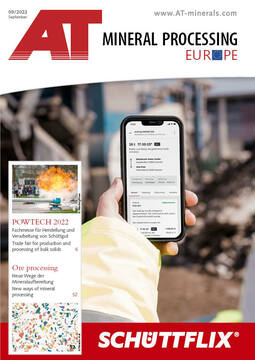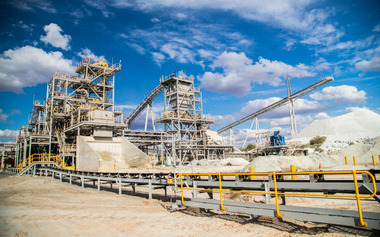Adding value of Lithium from contaminated material
The issue of basalt contamination
Mt Cattlin utilises a 2-stage crushing system followed by Dense Medium Separation (DMS) as the primary spodumene concentration process. The operation faces the challenge, typical of lithium mines, of dealing with basalt contamination: due to its high density – similar to that of spodumene – this high-iron, barren material is also concentrated by the DMS, contaminating the final product.
Keith Muller, General Manager at Mt Cattlin explains: “For us, it’s key to mine as clean as possible, but there’s always going to be contamination, mainly associated with contact or when there are basalt intrusions into the pegmatite. In these cases, there’s still lithium present in what we are mining, but it’s heavily contaminated with basalt. We segregate that from our clean ore sources and we stockpile it to be processed at a later stage.”
The solution: TOMRA PRO Secondary LASER sorter
Galaxy Resources has been stockpiling this material since 2016, while searching for an effective solution to treat it prior to processing in order to achieve a viable recovery level. In 2019, it installed optical sorters at the front-end of the plant to upgrade this low-grade ore. When it could not achieve the desired results, the company decided to explore other possible solutions with TOMRA Mining.
Successful test work at the TOMRA Test Center revealed that the TOMRA PRO Secondary LASER sorter would be an effective solution. TOMRA’s team was so confident of its performance, that it agreed on the very tight performance guarantees set by Galaxy Resources. The sorter has been operating since September 2021 sorting the contaminated low-grade ore. Keith Muller explains the process: “The ore is screened into two size ranges: 14 mm to 25 mm and 25 mm to 75 mm and then fed into the sorter. The sorter product is then recirculated into the crushing circuit, crushed down to a -14 mm particle size and fed into the wet plant and DMS.”
Since the first day of operation, it has met and exceeded expectations: “Our target is to have 4 % basalt in the product when it comes out of the TOMRA sorter; it has been consistently below this mark,” says Scott Green, Process Enhancement Coordinator. “It’s been continuous, there hasn’t been a degradation in performance,” adds Keith Muller. “It has worked well from the start and six months in it’s still performing as well as it did with the initial acceptance testing. We have pushed the boundaries of the industry standard in particle size and feed rate, and we haven’t found the limit of the machine yet.” Matthew Bateman, Principal Metallurgist at Galaxy Resources agrees: “We have 1.2 million tonnes to treat, and we will have treated the best part of it in 9 to 12 months. With the TOMRA sorter, we are using far more contaminated ore than we would previously have processed.”
On the back of the TOMRA PRO Secondary LASER sorter’s success, Galaxy Resources has acquired a second unit to expand secondary ore sorting capacity.
Seamless installation, simple operation, easy maintenance, maximum uptime
Installation was completed seamlessly despite the complications due to the Covid-19 pandemic, thanks to TOMRA’s careful planning and its team’s effective virtual support throughout the process. “In terms of commissioning, I was very surprised at how quickly and easily it went, especially with the constraints on travelling. When we commissioned the TOMRA unit, we still had border closures, so everything was done remotely, and it went very smoothly without any issues,” says Keith Muller.
The training TOMRA provided for the Mt Cattlin operators and maintenance teams also contributed to the smooth start up. “Being shown the key points they have to look at, what to keep an eye on before they even started the machine, gave the operators the confidence that they knew the machine before they even turned it on. We’ve never had this from a supplier before,” explains Scott Green.
In addition, TOMRA PRO Secondary LASER sorter is remarkably user friendly: “Operators like the simplicity of the HMI of the control panel, how simple it is to use. Once you get it up and running, it runs and runs and runs until you tell it to stop.” Maintenance is another plus of the sorter: “We run the sorter 24/7. When we’re on the small size fraction we get a lot of mica, so it needs a clean every 1 to 4 hours, depending on how muddy it is. On the 75 mm fraction, we can go 6 to 7 hours without stopping to clean. And it only takes about 20 min, so it’s back up and running very quickly. In terms of routine maintenance, we use the opportunity provided by the scheduled weekly shut down for maintenance of the infrastructure to give it a thorough clean and check-up.”

